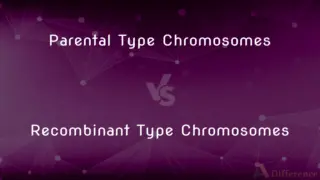Pentose Phosphate Pathway vs. Glycolysis — What's the Difference?
By Tayyaba Rehman — Published on January 9, 2024
The Pentose Phosphate Pathway generates NADPH and ribose-5-phosphate, while Glycolysis breaks down glucose to produce ATP and pyruvate.

Difference Between Pentose Phosphate Pathway and Glycolysis
Table of Contents
ADVERTISEMENT
Key Differences
The Pentose Phosphate Pathway (PPP) and Glycolysis are two distinct metabolic pathways in cells. PPP is primarily involved in producing NADPH, used in biosynthetic reactions, and ribose-5-phosphate, crucial for nucleotide synthesis. In contrast, Glycolysis is the process of breaking down glucose into pyruvate, generating ATP, the energy currency of the cell, and NADH.
PPP operates in parallel to glycolysis and is significant in cells that require large amounts of NADPH, such as in fatty acid synthesis and in maintaining glutathione in a reduced state in red blood cells. Glycolysis is a universal pathway present in almost all cells, providing energy and metabolic intermediates for other pathways, including the PPP.
The Pentose Phosphate Pathway can be divided into two phases: the oxidative phase, which generates NADPH, and the non-oxidative synthesis of 5-carbon sugars. Glycolysis, on the other hand, consists of ten enzymatic steps that convert glucose into pyruvate, with the net production of two ATP molecules and two NADH molecules per glucose molecule.
PPP is not directly involved in ATP production but plays a crucial role in cellular defense against oxidative stress and in the pentose sugar production for nucleotides. Glycolysis is a major pathway for ATP production, especially in conditions where oxygen is limited, such as in muscle cells during heavy exercise.
While both pathways are essential for cellular metabolism, PPP is more active in cells involved in anabolic processes, while Glycolysis is a fundamental energy-producing pathway in both aerobic and anaerobic conditions.
ADVERTISEMENT
Comparison Chart
Main Products
NADPH, ribose-5-phosphate
ATP, pyruvate
Role in Metabolism
Biosynthesis, antioxidant defense
Energy production, pyruvate generation
Phases
Oxidative and non-oxidative
Ten enzymatic steps
Energy Production
Does not produce ATP directly
Produces ATP
Cellular Significance
Active in anabolic cells, reduces oxidative stress
Universal pathway for energy, active in all cells
Compare with Definitions
Pentose Phosphate Pathway
Generates ribose for nucleotide synthesis.
The PPP is crucial in rapidly dividing cells for DNA replication.
Glycolysis
Involves ten enzymatic steps.
Glycolysis starts with glucose and ends with pyruvate, producing ATP.
Pentose Phosphate Pathway
Consists of oxidative and non-oxidative phases.
The oxidative phase of PPP generates NADPH needed for biosynthesis.
Glycolysis
A process of breaking down glucose to produce ATP and pyruvate.
Glycolysis is a key energy-producing pathway in muscle cells during exercise.
Pentose Phosphate Pathway
A metabolic pathway producing NADPH and ribose-5-phosphate.
The pentose phosphate pathway is essential in cells for fatty acid synthesis.
Glycolysis
Generates energy in both aerobic and anaerobic conditions.
Even in the absence of oxygen, glycolysis can provide energy to cells.
Pentose Phosphate Pathway
Important for cellular defense against oxidative stress.
Red blood cells rely on the PPP to maintain a supply of reduced glutathione.
Glycolysis
Produces ATP and NADH from glucose.
Each molecule of glucose in glycolysis yields two molecules of ATP.
Pentose Phosphate Pathway
Does not produce ATP directly.
PPP complements glycolysis but focuses on generating NADPH rather than energy.
Glycolysis
Fundamental to cellular metabolism.
Glycolysis is a universal pathway present in almost all types of cells.
Glycolysis
A metabolic process that occurs in nearly all living cells in which glucose is converted in a series of steps to pyruvic acid and during which energy is released in the form of ATP.
Glycolysis
(biochemistry) The cellular degradation of the simple sugar glucose to yield pyruvic acid, and ATP as an energy source
Glycolysis
A metabolic process that breaks down carbohydrates and sugars through a series of reactions to either pyruvic acid or lactic acid and release energy for the body in the form of ATP
Common Curiosities
Does the Pentose Phosphate Pathway generate energy?
It doesn't directly produce ATP but generates NADPH for anabolic reactions.
What is the primary function of glycolysis?
To break down glucose into pyruvate, generating ATP and NADH.
Where does the Pentose Phosphate Pathway occur in the cell?
It occurs in the cytoplasm, parallel to glycolysis.
How is ATP produced in glycolysis?
Through a series of ten enzymatic reactions breaking down glucose.
Is glycolysis an aerobic or anaerobic process?
It can occur in both aerobic and anaerobic conditions.
Can glycolysis occur without oxygen?
Yes, glycolysis does not require oxygen.
What are the end products of the oxidative phase of PPP?
NADPH and ribulose-5-phosphate.
What is the Pentose Phosphate Pathway?
It's a metabolic pathway producing NADPH and ribose-5-phosphate.
Is glycolysis active in all types of cells?
Yes, glycolysis is a fundamental metabolic pathway in nearly all cells.
What types of cells rely heavily on the Pentose Phosphate Pathway?
Cells engaged in anabolic processes and those needing to combat oxidative stress.
What happens to pyruvate after glycolysis?
Pyruvate can enter the mitochondria for further oxidation or be converted to lactate.
What role does the non-oxidative phase of PPP play?
It helps in the synthesis and interconversion of five-carbon sugars.
Why is NADPH important in metabolism?
It is crucial for biosynthetic reactions and maintaining cellular redox balance.
Does the Pentose Phosphate Pathway link to other metabolic pathways?
Yes, it intersects with glycolysis and nucleotide synthesis pathways.
How many ATP molecules are produced in glycolysis?
Two ATP molecules per glucose molecule.
Share Your Discovery

Previous Comparison
Functionalism vs. Neofunctionalism
Next Comparison
Parental Type Chromosomes vs. Recombinant Type ChromosomesAuthor Spotlight
Written by
Tayyaba RehmanTayyaba Rehman is a distinguished writer, currently serving as a primary contributor to askdifference.com. As a researcher in semantics and etymology, Tayyaba's passion for the complexity of languages and their distinctions has found a perfect home on the platform. Tayyaba delves into the intricacies of language, distinguishing between commonly confused words and phrases, thereby providing clarity for readers worldwide.














































